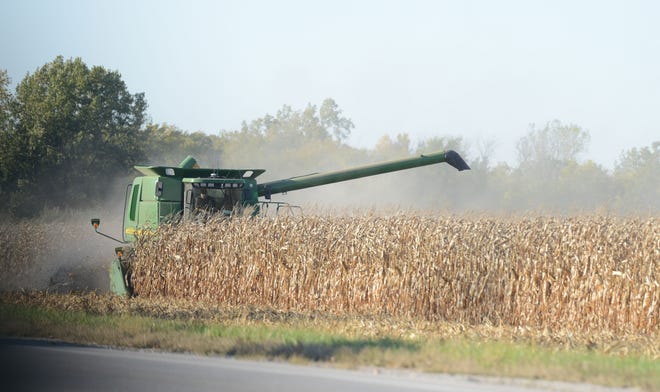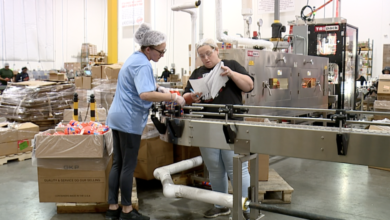

When Terry and Ernest Bateson hear rumbling, they know the trucks are coming.
Every year, semi-trucks filled to the brim with liquid manure drive by the retired farmers' home in Wood County's Portage Township. The semi-trucks are carrying waste from the CAFOs, or "concentrated animal feeding operations" – in layman's terms, factory farms.
"The road turns brown from the spillage," Ernest Bateson said.
The number of animals in the Maumee watershed has doubled from 9 to 20 million from 2005 to 2018, a study by environmental advocates found. More animals mean more poop – and the poop has to go somewhere.
Some of the poop is ending up in Lake Erie. Farmers spread manure on the fields as fertilizer, and it runs into the Maumee watershed, which flows into the lake.
Manure is a major source of phosphorus, the nutrient that causes algae blooms in Lake Erie. Algae blooms caused Toledo's tap water to be undrinkable in 2014.
Gov. Mike DeWine's initiative, H2Ohio, is meant to prevent crises like the one in Toledo from happening by reducing phosphorus runoff, which largely comes from farms. But two years later, critics say H2Ohio isn't doing enough to reduce phosphorus runoff from manure.
"The Maumee River looks like the Chicago River on St. Patty's Day," said Dave Housholder, a neighbor of the Batesons.
What is H2Ohio doing to reduce phosphorus runoff?
H2Ohio has 10 best management practices farmers can use to reduce phosphorus levels. The voluntary program starts with soil testing and creating a plan of what practices the participating farm can use. Then, Ohio's soil and water conservation districts check if the farmers have implemented those practices and cut a check at the end of the growing season.
In the program's first year, 1,800 farmers participated, which officials said covers about 40% of total farmland acres in the Maumee watershed.
"We're working pretty aggressively to meet our reduction goal. Of course there will be critics that say we aren't moving fast enough," said Joy Mulinex, Executive Director of the Ohio Lake Erie Commission. "I understand their frustration, but it took us a while to get this much phosphorus flowing into Lake Erie, and so it's probably going to take a little bit of time to turn the spigot off."

One of the practices, manure incorporation, mixes manure into the soil instead of applying it on the surface to minimize phosphorus runoff.
"Our data just shows that manure is not the large load contributor that I think some people feel that it is," Mulinex said.
A 2016 report from the University of Michigan determined about 23% of phosphorus applied to the soil in the Maumee watershed is from manure. However, a study by environmental advocates reported phosphorus runoff from manure increased 67% from 2005 to 2018.
The H2Ohio manure incorporation program also pays farmers to haul manure to areas with lower phosphorus concentrations. Advocates and experts say the program benefits the environment and allows manure to be used instead of commercial fertilizer. Mulinex said the program helps farmers move nutrients to the fields that need them, instead of overapplying manure fertilizer.
Jeff Duling, a farmer who uses H2Ohio practices, believes the program has been a huge success. He said the voluntary incentives even got his stubborn uncle to follow manure incorporation rules.
"We're doing a darn good job out here. It's not about the money, it's us farmers want to do it right," Duling said. "They're saying how bad the lake is, but it's beautiful up there. That lake was so dirty when I was a kid."
Duling said "city folk" don't understand that farmers don't want the nutrients from manure to runoff into Lake Erie. They want them in the soil because commercial fertilizer is expensive, and farmers want to use all the nutrients they can get from their own manure.
Where advocates say H2Ohio falls short
Jeff Reutter, retired director of the Ohio Sea Grant and Ohio State University Stone Laboratory, said H2Ohio's voluntary incentives and rules aren't enough.
Reutter believes in H2Ohio's efforts to expand and create wetlands, which help remove phosphorus from water, but said the incentives have "absolutely no permanence."
Sandy Bihn, executive director of the Lake Erie Waterkeeper Association, said the program to move manure around wouldn't be necessary if the CAFOs didn't produce so much manure in the first place. She said the lake would be fine now if Ohio didn't keep adding manure.
Housholder, a grain farmer and former trustee of Portage Township, said the program is a waste of taxpayer money. He was given the opportunity to join H2Ohio programs but passed.
"H2Ohio is basically focused on how do we cover up the fact that we've allowed this much waste to be generated," Housholder said. "The CAFOs need to be held liable. How long can we foolishly spend taxpayer money and not have verifiable results?"
Many advocates and experts say the threshold for phosphorus soil test levels is too high for manure application, allowing farmers to get away with putting too much manure on the soil.
The current federal guidelines, which Ohio follows, allow for soil test levels of 150 parts per million (ppm) for manure application but only 50 ppm for commercial fertilizer. Advocates and experts want to see the guidelines lowered to 50 ppm for manure too. The H2Ohio program requires participants to keep their phosphorus soil test levels, regardless of source, to under 50 ppm.
Ty Higgins, an Ohio Farm Bureau spokesperson, said comparing commercial fertilizer phosphorus levels to manure phosphorus levels "is like comparing apples to oranges."
According to Higgins, there are scientifically proven benefits to putting manure in the ground at the 150 ppm threshold, such as reducing soil erosion, which the U.S. EPA says reduces runoff.
Reutter disagrees. He said manure only has benefits when the phosphorus levels are under 50 ppm. According to Reutter, unregulated farms, which make up 84% of cattle manure according to environmental advocates, have also resulted in an increase of manure at a worrying scale.
"The bottom line is regulated farms are allowed to put on too much [manure] if they follow the regulations, and who knows how much the unregulated farms are doing?" Reutter said. "They can do anything they want."
Duling, the farmer, said he's been trying to use 50 ppm as a benchmark on his farm per H2Ohio rules and he "wouldn't be surprised" if the majority of farmers are already following the 50 ppm guideline.
So... how's Lake Erie actually doing?
The National Oceanic and Atmospheric Association is forecasting a smaller-than-average algae bloom in Lake Erie this summer. This will be the first time in over a dozen years that mild blooms have happened in back-to-back years.
That can be attributed to extremely dry weather, as rain is what drives phosphorus runoff into Lake Erie, said Laura Johnson, the director of the National Center for Water Quality Research at Heidelberg University.
Ohio's goal is to reduce phosphorus in Lake Erie by 40% by 2025 under a 2012 amendment to the Great Lakes Water Quality Agreement. H2Ohio was meant to help Ohio reach that goal.

Johnson said phosphorus concentration is still well above the target. She said it's too soon to tell whether H2Ohio's initiatives will result in reduced phosphorus runoff, but she supports the program's best management practices.
The Ohio Farm Bureau claimed this year that the state is one-third of the way to accomplishing Ohio's phosphorus reduction goal through the H2Ohio program.
Reutter, who helped set the goal, said the Ohio Farm Bureau's numbers were wrong. The amendment set a standard way of measuring phosphorus levels, and according to that form of measurement, the phosphorus levels this year are the same as they were in 2008.
The Ohio Lake Erie Commission estimates phosphorus runoff will be reduced by 18% after every H2Ohio program funded in this fiscal year is fully implemented.
Say Ohio does have a poop problem. What's the solution?
Some advocates and experts want a moratorium on CAFO permits until regulations can be put in place, particularly one which lowers phosphorus soil test thresholds for manure application.
The Ohio Department of Agriculture is currently reviewing several permit applications for CAFOs. The agency reviews CAFO regulations every five years and updated the rules last year.
Two Democratic lawmakers from Toledo, Rep. Michael Sheehy and Rep. Paula Hicks-Hudson, sponsored a bill that would block new CAFO permits if the CAFO is in the Maumee watershed and phosphorus concentration reaches a certain level in the preceding year.
Sheehy said the bill is a "tough sell" and referred to the Ohio Farm Bureau, which opposes the bill, as the "strongest lobby in the state."

The Ohio Farm Bureau said the CAFOs are regulated strictly enough and supports H2Ohio's solution for phosphorus runoff reduction. The state is expanding the program to 10 more counties in the Western Lake Erie Basin.
Terry and Ernest Bateson don't know much about the H2Ohio program – they just want the smell to go away.
"They're definitely not good neighbors," Ernest Bateson said. "If I had a stink in my yard and it was blowing towards the neighbors they'd try and put me in jail."
Grace Deng is a reporter for the USA TODAY Network Ohio Bureau, which serves the Columbus Dispatch, Cincinnati Enquirer, Akron Beacon Journal and 18 other affiliated news organizations across Ohio.
Source link






